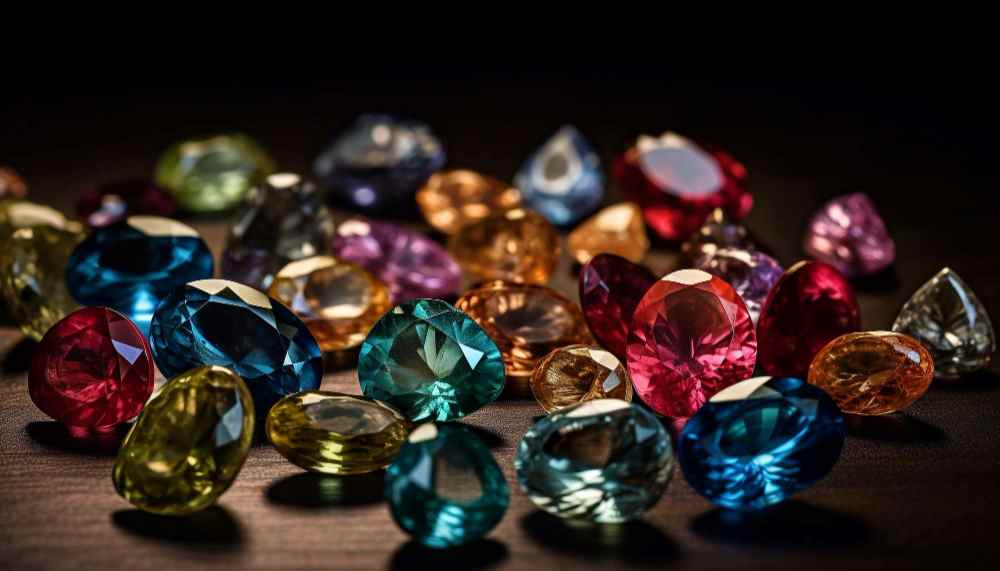How to Identify Synthetic Gemstones
Gemologists and jewelry buyers employ various methods to ascertain whether or not a gemstone is natural, including visual inspection and the use of testing instruments such as jeweler’s loupe, reflectometer, and refractometer.
Learning how to tell apart synthetic gems from their natural counterparts is an invaluable skill for any gemologist. Here, discover how you can identify synthetic gemstones by looking out for telltale signs they leave behind.
Color

Color can often be the definitive indicator of whether a gemstone is natural or synthetic, with natural gems usually possessing more vibrant and intense hues, while many synthetic gemstones often boast muted, less saturated tones. Furthermore, natural stones often feature unique characteristics like inclusions or other imperfections which add greater value while some synthetics appear almost devoid of such characteristics altogether.
With a loupe (jeweler’s magnifying glass), one can determine some general characteristics of synthetic gemstones, including lack of inclusions and unusually high clarity levels. But this method cannot guarantee identification: other methods must also be employed.
Another method is examining a stone’s color for signs of synthetic production. An unusually fine clarity could indicate synthetic corundum production; few natural gemstones reach 10X clarity levels let alone higher.
Other telltale signs of synthetics include quench crackling found in certain synthetics. Heat treatment also creates unique features that can be easily detected – for instance a corundum manufactured through flame fusion may exhibit honeycomb characteristics due to its wavelike growth structure, while imitations can often be identified by looking out for naturally occurring fractures or fingerprints with non-wavy features.
Clarity

One of the easiest ways to differentiate synthetic from natural gemstones is by inspecting their clarity. Lab-grown gems tend to be much cleaner, with fewer inclusions and whiter or brighter colors than their natural counterparts; depending on how they were created however, some lab-created stones may contain inclusions similar to natural ones – thus why only dealing with trusted retailers who offer certificates from independent gemological laboratories is essential in making an accurate identification of a lab-grown stone.
As well as scrutinizing the clarity of stones, it’s also essential to take note of their weight and measurements. Synthetic gemstones often weigh more than their natural counterparts due to being manufactured using denser materials like cubic zirconia; another easy way of distinguishing synthetics from genuine ones is comparing color variations; genuine gems typically feature varied hues while synthetics typically lack such variance.
While most synthetic gemstones can be identified easily with trained eyes, detecting others can be more challenging even for experts. When this occurs, gemological laboratory certification is the ideal way to ensure that each stone is correctly classified based on natural or synthetic status, any treatment or origin issues, and more advanced tests like fluorescence analysis and EDXRF to confidently differentiate authenticity when visually unrecognizable gems remain.
Inclusions

At first glance, synthetic gems can often be identified by their inclusions. Each synthetic gemstone manufacturing process creates unique trademark inclusions that enable gemologists to tell apart genuine and lab created stones – however due to these similarities being hard to see without proper equipment, gemologists sometimes misidentify lab-created stones as genuine gemstones.
Inclusions can help identify a lab-created corundum (ruby or sapphire) as being synthetic, especially if it exhibits heat induced finger prints or quench crackling that should never appear in genuine rubies. Furthermore, fluorescence testing is highly diagnostic; always evaluate it alongside microscopic examination to make an accurate assessment.
One simple way to distinguish natural from synthetic corundum is to look for exceptionally fine clarity. Although difficult to identify with a loupe, if a gem displays extremely fine clarity it’s likely made of synthetic material and should not be trusted as being genuine.
Other ways of detecting synthetic gems include sniffing out any unusual scents or temperatures that would indicate they are flame fusion gems, fluorescence is often an effective tool in identifying colorless synthetics that have strong phosphorescence when illuminated by UV light, while for more advanced identification tests like EDXRF or trace element chemistry additional tests may be required for more advanced identification.
Treatments

As a gemologist, your primary tool in identifying whether a gemstone is genuine or synthetic will be color. Examine it under daylight-equivalent lighting to see its hue (composed of saturation, tint and shade). A consistent tone and saturation level across its entirety indicates it was not dyed.
Certain gemstones are colored by adding metallic elements to their chemical structures, most often sapphire, ruby and emerald but even amber can sometimes be colored using this method. When this occurs the resultant material is known as simulants but does not possess equal value compared to natural stones with similar coloring.
Other colors may be added through direct dyeing or irradiation, which are difficult for untrained eyes to detect; only an experienced gemologist is capable of accurately identifying such stones with certainty.
If a gemstone has been treated, its treatment must be clearly disclosed and discussed. This will enable buyers to differentiate between treated and untreated specimens and identify potential issues regarding origin or treatment of stones they purchase; genuine gems with unmodified surfaces have more value both when bought new and when sold second hand; by learning about all of the treatments that may occur with gemstones you’ll become an informed collector or jewelry buyer.







